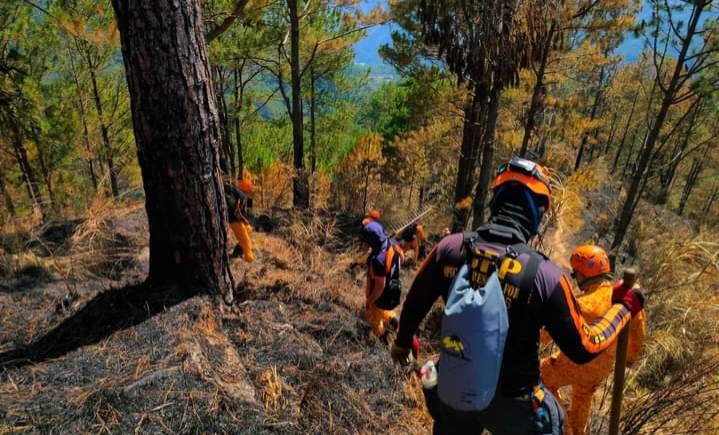
INTO THE WOODS Wildfire combat experts from the US Agency for International Development train Cordillera firemen in battling forest fires at Sitio Bonecow, Barangay Loacan in Itogon town, Benguet, in this photo taken on Feb. 28. At least four incidents of forest fire continue to ravage the mountain terrain of Benguet province as of March 4. —BUREAU OF FIRE PROTECTION-CORDILLERA
BAGUIO CITY—Cordillera’s firefighters continued to battle four incidents of forest fire in Benguet province, but most of the blazes were already contained weeks after razing the mountain terrain.
As of Monday, the Bureau of Fire Protection (BFP) in the Cordillera had already managed to put out a total of 72 forest fires and 31 structural fires that struck some parts of the region from January to early March, according to Enrique Gascon, Cordillera director of the Department of Social Welfare and Development.
Records from the BFP showed that at least 79 incidents of forest fire were recorded in the region as of Monday, including the four still ongoing in Benguet, added Gascon, who was the keynote speaker during Monday’s ceremonial launch of this year’s Fire Prevention Month at Burnham Park here.
Most of the blaze consumed thick tree cover in the Benguet towns of Bokod, Bakun, Itogon, Tuba and parts of this city, as well as in the borders of Mountain Province.
The flames had so far destroyed 590 hectares of woodlands, based on an estimate provided to the Cordillera Disaster Risk Reduction and Management Council (CDRRMC) at a Feb. 22 assessment meeting.
Aerial suppression
Satellite images recorded on Feb. 24 by the Philippine Space Agency showed the flames spreading through forests in the towns of Bakun, Itogon and Tuba.
Firemen and a contingent of helicopters flown by Philippine Air Force pilots were still in the process of extinguishing four forest fires in Benguet, although firefighters have successfully prevented them from spreading, according to the BFP.
The Air Force choppers have been carrying huge water containers to suppress the flames.
Fire Senior Supt. Robert Pacis, BFP Cordillera director, said highland communities need to collaborate and prevent more forest fires, noting that the region’s mountains have been “crying for help.”
The fires have been attributed to poorly doused bonfires and cigarettes, the region’s traditional “kaingin,” or slash-and-burn farming, and the expanding agriculture activities intruding into forestland.
UP IN FLAMES Fire rages in a section of forests of Sitio Lebang and parts of Barangay Tabaan Sur in Tuba, Benguet, in this photo taken on Feb. 22. —NEIL CLARK ONGCHANGCO
Rains have also been sparse since January, owing to the drought and dry spell accompanying the prevailing El Niño weather phenomenon.
High-velocity winds have also made firefighting within smoldering Benguet timberland a safety concern.
US aid
Toward the end of February, American firefighters also lent a hand in training the Cordillera’s firefighters to construct strategic fire lanes and map out escape routes for fire responders, according to Albert Mogol, Cordillera director of the Office of Civil Defense (OCD).
The OCD and the CDRRMC reached out to the US Agency for International Development (USAID) for assistance last month.
READ: LOOK: PAF continues heli bucket operations vs Benguet forest fire
USAID dispatched wildfire combat experts Ben Hemingway, Rachel Gallagher and Robb Chapman from its Bureau of Humanitarian Assistance on Feb. 27 to review the ongoing firefighting operations and to recommend fire management procedures for BFP personnel assigned to forested towns and their counterparts in the Department of Environment and Natural Resources and the local governments.
In a statement from the US Embassy that was shared on the OCD social media page on March 2, the USAID experts provided the BFP and other firefighting volunteers with “basic wildfire training and support, including fire line construction techniques, use of hand tools and lookouts, escape routes, and safety zones.”
In the CDRRMC’s Feb. 22 report, firemen assigned to forest areas need specific equipment to combat forest fires, among them a “spotter” or aerial drone that will help firefighters plan how to beat the blaze and secure the best routes that they could use to avoid being trapped there. INQ